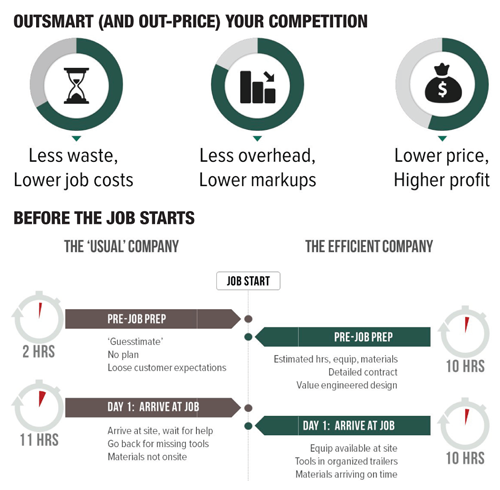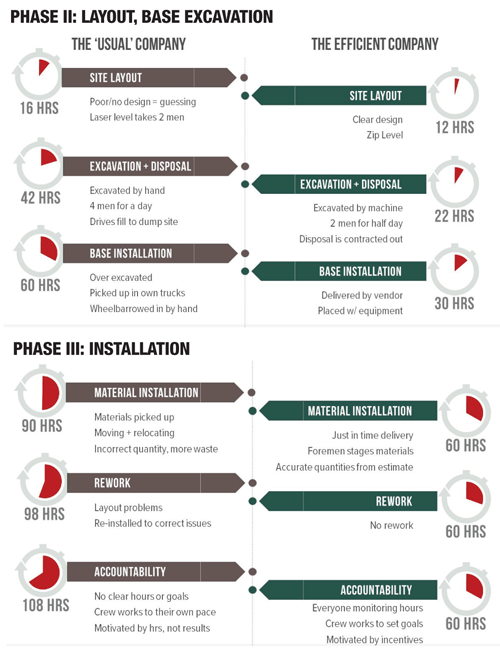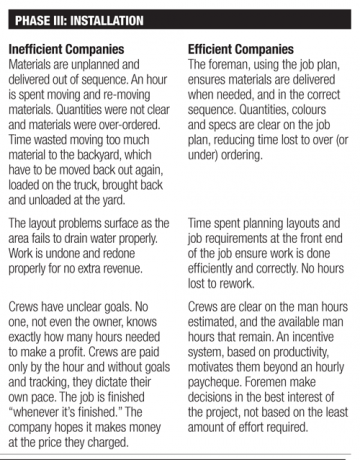January 6, 2015
Jobsite Logistics
The sure way to competitive prices and higher profits
MARK BRADLEYThere’s no doubt that our industry is hurt by low price and low quality competition. The low barriers to entry, lack of consumer education and lack of clear differentiating standards (recognizable to those outside the industry) also mean this problem will take a long time to change.
 Efforts to help turn this tide by our associations, industry mentors, visionaries and others are admirable — and may well change the future for the next generation of this industry — but the climate today is likely to be the same for the next 10 years and perhaps more.
Efforts to help turn this tide by our associations, industry mentors, visionaries and others are admirable — and may well change the future for the next generation of this industry — but the climate today is likely to be the same for the next 10 years and perhaps more.You’ll find no comfort in blaming these competitors for our problems, missed sales opportunities and lower profits. It may soften the sting of a lost job but you must look inward to fix these problems. You can’t fix the industry overnight. But you can fix your company.
To compete on low price, but without sacrificing profit, you must beat these competitors on efficiency. It can’t be that difficult. If they truly are the low-price “bottom-feeders” we peg them as, then it’s very likely that their unsophisticated business practices are backed up by inefficient, poorly-planned jobsites. The way only way to face this competition — and still make a profit — is to finish your jobs faster.
By finishing your jobs faster, you’ll finish more jobs in the same working hours. By finishing more jobs in the same timeframe, you’ll reduce your overhead…which will allow you to compete at a lower price, or will allow you to improve your net profit.
A company with an overhead of 20 per cent can compete against a company with an overhead of 25 per cent, but make five per cent more profit — even if the job costs between the two companies are identical.
By keeping a close eye on your first 10 jobs, you’ll spot the inefficiencies, the wasted hours, and the poor work practices that are not only increasing the time (and costs!) of your jobs, but they are also robbing your company of valuable sales opportunity that will not only increase your revenue, but it will also reduce your overhead as a percentage.

The efficient company finishes a job in 33 per cent less time than the inefficient company. While the inefficient company bumbles through mistakes, waste, and rework, the efficient company is off to start the next job — generating more revenue for the same overhead, the same payroll, and the same fixed equipment costs.
With lower job costs and overhead come higher profits. Some of these profits reward the owner. Some of these profits get reinvested back into the business. Higher wages attract better people. Newer equipment improves efficiency even further. Better people and newer equipment lead to even faster production times and a significant competitive advantage over the “bottom-feeders” of the industry.
We’ll all still lose jobs to price. It happens in every industry. But you simply can’t compete in a low-margin industry at the same speed and efficiency of companies who are giving away their work.

As it stands today, there is only one real way to compete with the “bottom half”:
- Improve your brand and image. Show the customer why you’re worth every penny you’re asking for.
- Get your jobs done efficiently. You can compete on price, if you can do the work for less cost.
- Constantly improve. Invest in fixing your inefficiency. Improve your staff. Improve your equipment. Improve your systems.
Mark Bradley is president of TBG Landscape and the Landscape Management Network (LMN), in Ontario. LMN provides education, tools and systems built to improve landscape industry businesses.